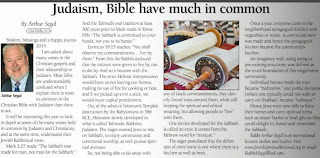Shalom, Blessings and a Happy, Joyous 2014!
I am asked about many verses in the Christian Gospels and their relationship to Judaism. Most folks are understandably confused when I explain there is more in common in the Christian Bible with Judaism then there is not.
I will be interesting this year to look in depth at some of the many verses held in common by Judaism and Christianity, and at the same time, understand their Jewish Rabbinical roots.
Mark 2:27 reads: ''The Sabbath was made for man, not man for the Sabbath.'' And the Talmud's oral tradition, at least 500 years prior to Mark reads in Yoma 85b: "The Sabbath is committed to your hands, not you to its hands.''
Leviticus 18:15 teaches: "You shall observe My commandments… live by them." From this the Rabbi's deduced that the mitzvot were given to live by, not to die by. And so it became with the Sabbath. The strict Hebraic interpretation would have us not leaving our homes, making no use of fire for cooking or heat, and if we picked up even a stick, we would incur capital punishment.
Out of the ashes of Solomon's Temple's destruction by the Babylonians in 586 BCE, Hebraism slowly developed in what is called Talmudic Rabbinic Judaism. The Sages wanted Jews to rest on Sabbath, to enjoy community and communal worship, as well pursue spiritual avenues. So, not being able to do away with any of God's commandments, they cleverly found ways around them, while still keeping the spiritual and ethical meaning, but allowing people to 'live' with them.
One device developed for the Sabbath is called an Eruv. It comes from the Hebrew word for 'mixture.' The sages postulated that the definition of one's home is one where there is a kitchen as well beds. Once a year, everyone came to the neighborhood synagogue's kitchen with vegetables, or meats. A communal stew was made and hence the synagogue's kitchen became the community's kitchen. An imaginary wall, using string or pre-existing structures, was defined as the Eruv's boundaries of this mega-community home. Individual homes inside this Eruv became 'bedrooms', and public domains (where one could not walk or carry on Shabbat), became 'hallways.' Hence Jews were now able to leave their homes, and carry spiritual items such as prayer books, or food gifts, so they could delight in, honor and remember the Sabbath.
Next month, we will continue.
Rabbi Arthur Segal is an international lecturer, author, and teacher. Visit him at www.JewishSpiritualRenewal.org . Follow him on FaceBook at 'Arthur L Segal', on Twitter at RabbiASegal, or his blog at http://rabbiarthursegal.blogspot.com . Email at RabbiASegal@aol.com .
www.JewishSpiritualRenewal.com/books www.FaceBook.com/Arthur.L.Segal www.FaceBook.com/RabbiArthurSegalJewishSpiritualRenewal www.RabbiArthurSegal.blogspot.com
Jewish Spiritual Renewal
Jewish Renewal
Jewish Spirituality
Hilton Head Island, SC; Bluffton, SC; Savannah, GA


























